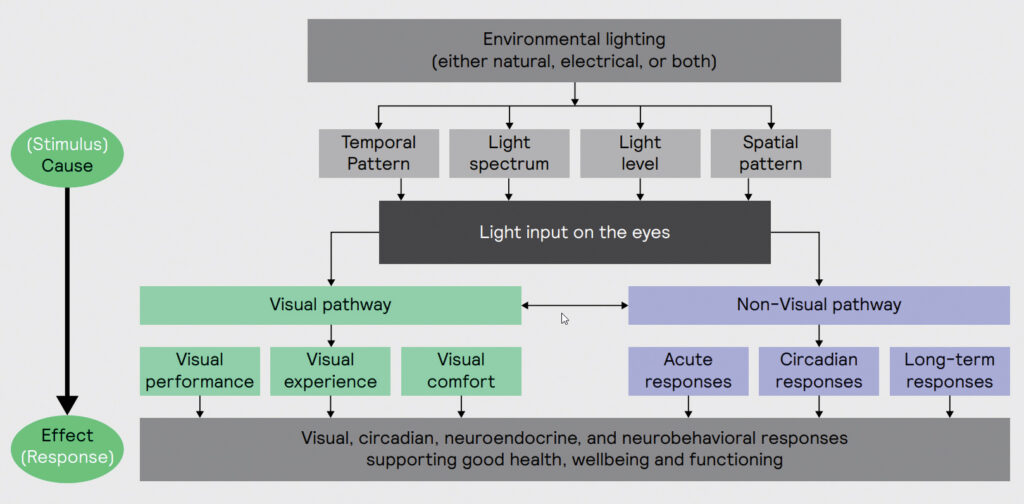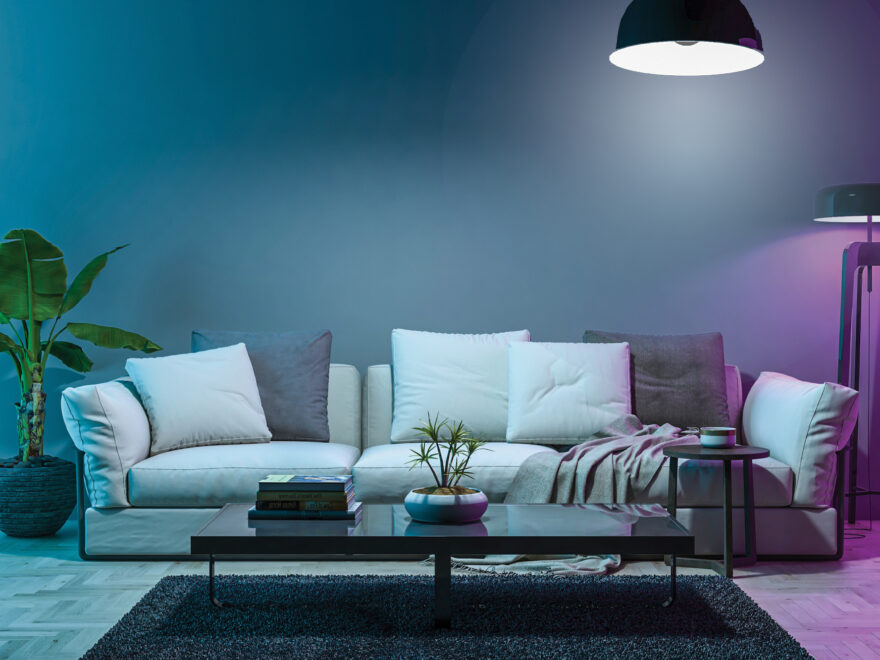Next to being essential for vision, light has important functions beyond vision, often referred to as non-visual or non-image forming effects/responses.
Light regulates our physiology (hormones), behavior, mood and circadian rhythms, thus controlling our ability to remain awake and concentrate (for work/learning) or to fall (or remain) asleep.
The importance of circadian rhythms for health and well-being is underlined by the 2017 Nobel Prize for Physiology or Medicine which was awarded jointly to Jeffrey C. Hall, Michael Rosbash and Michael W. Young for their research on molecular mechanisms controlling the circadian rhythm and sleep-wake patterns. At the beginning of the 21st century a new retinal photoreceptor was discovered, the intrinsically-photosensitive retinal ganglion cell (ipRGC). In addition to receiving extrinsic signals from rods and cones, these cells have an intrinsic sensitivity to light that is based on the photopigment melanopsin. The light sensitivity curve of this melanopsin-based photoreception peaks at around 480nm. Light at this wavelength is therefore denoted as ‘melanopic light’.
The increased focus on health and well-being in office design goes hand in hand with LED technology and scientific research on the visual and non-visual effects of light on humans to improve working environments for office employees. This is particularly due to the ability to fine tune the specific light spectrum and intensity of individual luminaries.
Most of our indoor environments leave us light-deprived as compared to the natural light exposure during daytime outdoors. Twilight on a semi-overcast day has a maximum (horizontal) illuminance of about 400 lux, and as such one could say that an indoor illuminance of 500 lux horizontally, which is typical of most offices, is rather modest and is not much better than twilight.
Insufficient daytime light exposure compromises vitality, mood, activities, and health. Daytime light exposure is, together with nocturnal darkness, by far the most important and powerful biological signal to regulate the timing, robustness and strength of the body clock that structures our intrinsic circadian rhythm. It is a very important component to our health and well-being.
The following factors are important determinants for the ability of light to regulate the body clock:
1. Timing of light exposure: early morning light advances the body clock (this facilitates an earlier bedtime and sleep onset), while evening light delays the body clock (this facilitates a later bedtime and sleep onset).
2. Illuminance: higher light levels result in stronger effects (as long as the threshold for saturation is not yet reached)
3. Spectrum: effects are stronger when the spectrum has more melanopic content (as long as the threshold for saturation is not yet reached).
4. Exposure duration: increasing exposure duration increases effect size (in a non-linear fashion and as long as the threshold for saturation is not yet reached).
5. Light history: more daytime light exposure can reduce the (sleep-disruptive) impact of evening/nighttime light exposures.
6. Individual & application context: individual differences in light sensitivity are different for populations (such as children, seniors, shift workers, healthcare patients) and consequently have different lighting needs.
Traditionally, the design of workplace lighting in general, and office lighting in particular, has been largely driven by requirements that relate to visual, experiences and comfort. The lighting is primarily designed to ensure a good performance and comfort on visual tasks. With this very recent knowledge we now have the opportunity to make a meaningful difference to society via the application of good lighting design.

This has given rise to Melanopic lighting: Lighting solutions designed to activate the melanopsin-containing retinal photoreceptors that mediate the non-visual effects of light on our biorhythm, mood and brain regions involved in learning.
In December 2018 the CIE published an international standard to quantify the ability of a lighting system to activate the melanopsin-based (i.e. melanopic) photoreception of ipRGCs.
A CIE standard introduces two new parameters that can be used to objectively characterize effects related to melanopic light exposure:
1. melanopic EDI or melanopic equivalent daylight illuminance
2. melanopic DER or melanopic daylight efficacy ratio
The melanopic equivalent daylight (D65) illuminance (EDI) is a quantity that expresses the amount of melanopic light contained in a sampled light source. It is defined in international standard CIE S 026:2018. It expresses the melanopic activation of a particular test light in terms of the amount of lux of daylight D65. For instance, a melanopic EDI of 30 lux denotes that the test light condition has the same melanopic activation as 30 lux of daylight D65.
The melanopic daylight efficacy ratio (DER) is a dimensionless spectral metric that expresses the melanopic activation of a (test) light source as compared to daylight D65 (at the same photopic illuminance). For instance, a test light with a melanopic DER of 0.75 has 25% less melanopic activation (per lumen) as compared to daylight D65. By definition, the melanopic-DER equals 1 when the test light has the same melanopic activation per lumen as daylight D65. When the test light has a melanopic DER of 1.30 it has a 30% higher melanopic activation (per lumen) as compared to daylight D65. Natural light has a melanopic DER close to 1 during most of the day. However, during dawn and dusk the melanopic DER of natural light can increase to 1.75.
So what does this mean for good indoor lighting design? A recent CIE position statement advises to have light conditions with a high melanopic EDI during daytime, while low melanopic EDIs are recommended for sleep and rest supportive lighting in the evening and at night. Thus the following general design considerations are (and will be) more common in quality lighting designs;
1. Brighter light levels based on actual tasks/applications linked back to standards.
2. Higher Melanopic EDI light levels (potentially via additional Cyan LEDs in luminaries)
3. Controls based Circadian lighting, specifically tuned to the application at hand; ie a hospital application would have high indoor EDI lighting during the day, fading out at twilight for staff and patient comfort at night (actual illuminance levels would stay the same).
These principals are the basis of building standards such as WELL. These standards strongly promote a more natural and outdoor-like light-dark cycle improving the strength of the 24-hour rhythm of the body clock and its alignment with the behavioral sleep-wake cycle. This is supportive for general health and productivity and varies greatly from application to application.


